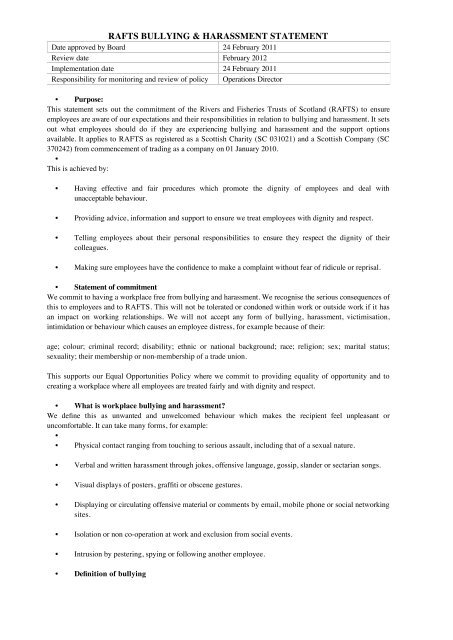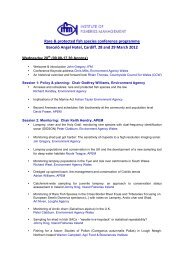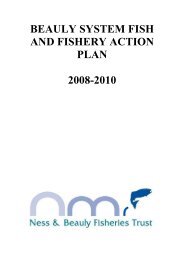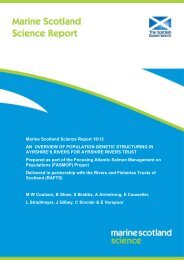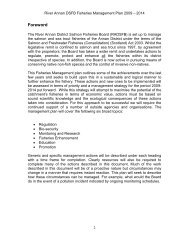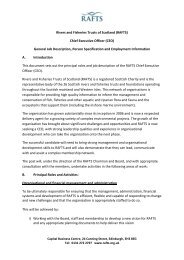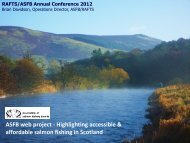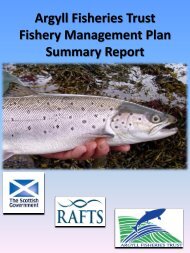RAFTS BULLYING & HARRASSMENT STATEMENT
RAFTS BULLYING & HARRASSMENT STATEMENT
RAFTS BULLYING & HARRASSMENT STATEMENT
Create successful ePaper yourself
Turn your PDF publications into a flip-book with our unique Google optimized e-Paper software.
<strong>RAFTS</strong> <strong>BULLYING</strong> & HARASSMENT <strong>STATEMENT</strong>Date approved by Board 24 February 2011Review date February 2012Implementation date 24 February 2011Responsibility for monitoring and review of policy Operations Director• Purpose:This statement sets out the commitment of the Rivers and Fisheries Trusts of Scotland (<strong>RAFTS</strong>) to ensureemployees are aware of our expectations and their responsibilities in relation to bullying and harassment. It setsout what employees should do if they are experiencing bullying and harassment and the support optionsavailable. It applies to <strong>RAFTS</strong> as registered as a Scottish Charity (SC 031021) and a Scottish Company (SC370242) from commencement of trading as a company on 01 January 2010.•This is achieved by:• Having effective and fair procedures which promote the dignity of employees and deal withunacceptable behaviour.• Providing advice, information and support to ensure we treat employees with dignity and respect.• Telling employees about their personal responsibilities to ensure they respect the dignity of theircolleagues.• Making sure employees have the confidence to make a complaint without fear of ridicule or reprisal.• Statement of commitmentWe commit to having a workplace free from bullying and harassment. We recognise the serious consequences ofthis to employees and to <strong>RAFTS</strong>. This will not be tolerated or condoned within work or outside work if it hasan impact on working relationships. We will not accept any form of bullying, harassment, victimisation,intimidation or behaviour which causes an employee distress, for example because of their:age; colour; criminal record; disability; ethnic or national background; race; religion; sex; marital status;sexuality; their membership or non-membership of a trade union.This supports our Equal Opportunities Policy where we commit to providing equality of opportunity and tocreating a workplace where all employees are treated fairly and with dignity and respect.• What is workplace bullying and harassment?We define this as unwanted and unwelcomed behaviour which makes the recipient feel unpleasant oruncomfortable. It can take many forms, for example:•• Physical contact ranging from touching to serious assault, including that of a sexual nature.• Verbal and written harassment through jokes, offensive language, gossip, slander or sectarian songs.• Visual displays of posters, graffiti or obscene gestures.• Displaying or circulating offensive material or comments by email, mobile phone or social networkingsites.• Isolation or non co-operation at work and exclusion from social events.• Intrusion by pestering, spying or following another employee.• Definition of bullying
conduct on others. This should ensure that employees:•• Treat fellow workers with dignity and respect.• Think about their behaviour and actions, and how these may impact on others.• Meet the requirements of <strong>RAFTS</strong> policy to ensure equal opportunity and non-discrimination.• Do not bully, harass, or victimise colleagues or any other person on any grounds.• Do not display behaviour or actions that are unwelcome or undermine fellow employees or any otherperson.• Report suspected acts of unacceptable behaviour or practices that go against the bullying andharassment policy.• Do not make false accusations with a deliberate attempt to damage another person’s reputation, dignityand character.• Additional responsibilities expected of managersManagers have a responsibility to uphold and promote the bullying and harassment policy. They should treatemployees fairly and with dignity and respect and make sure the working environment is free from bullying,harassment and victimisation. They should:•• Encourage an atmosphere of tolerance and respect.• Lead by example through a fair and open management style.• Make sure that all employees they are responsible for are aware of, and understand the bullying andharassment policy.• Be aware of their team member’s behaviours and take steps to address any action which may causeoffence or distress.• Be supportive of employees who come to them with concerns about unacceptable behaviour.• Stop unacceptable behaviour and deal with any complaints they receive.• Dealing with bullying and harassmentIt is preferable that complaints are dealt with informally where appropriate. The aim is to produce solutionsquickly to resolve issues and reduce the impact on all involved. The informal procedure should not be used todiscourage employees from using formal procedures where they prefer that option.• Seek support and adviceEmployees affected by bullying and harassment should not ignore the issue. There are 2 options available toresolve any issue.12.1 Informal procedureActs of bullying and harassment are not always intentional. Sometimes the person might not understand theimpact of their behaviour on someone else. That is why dealing with the matter informally may be appropriate.By making the person aware of the impact of their behaviour it might resolve the matter.The employee can, if they wish and are comfortable to do so, talk to the person directly about their behaviour,explain how it has affected them and ask them to stop behaving in that way. If they find it too difficult to dothis on their own they can ask a colleague or their line manager to do this for them. If the person is their linemanager they can ask a member of the <strong>RAFTS</strong> Board to talk to them. If the complaint is not resolvedinformally or if the employee wishes they may progress to the formal approach.
12.2 Formal procedure - making a complaintThe employee should provide details of the complaint and what or whether attempts they have taken to resolvethe matter informally. They should then pass this to their line manager. If however the complaint is about theirline manager they should pass this to a member of the <strong>RAFTS</strong> Board.The line manager or board member will independently and impartially review the information provided. Theywill determine if the behaviours fall under the definitions of bullying and harassment and decide if any furtherinvestigation is required.• False accusationsIf in good faith an employee makes an accusation which following investigation is not confirmed as bullyingand harassment, <strong>RAFTS</strong> will not take any action against the employee. If however an employee makes amalicious complaint which does not have grounds, substance or evidence and was made to deliberately causeupset and distress we may take action in line with our Disciplinary and Appeals Procedure.• Investigation processThe investigator will complete a through impartial investigation to find out if bullying and harassment hastaken place and decide what action needs to be taken. They will keep an open mind, looking at all theinformation and evidence which supports the complaint and evidence against it.Anyone involved in the process at any stage has the right to representation by a trade union representative, linemanager or colleague of their choice. This person must not have an active role in the investigation process, forexample as a witness.Initially the investigator will advise everyone involved of the planned approach to dealing with the complaint,proposed timescales and how they will confirm the outcome. They will interview the complainant to clarify fulldetails of the complaint, followed by the respondent and any witnesses in order to gather all relevant evidence.They will then review the information to establish the facts of the case and prepare a report summarising theirfindings and conclusions. The report will confirm whether they have upheld or rejected the complaint and detailrecommendations of appropriate action for management to take.Investigation outcome - The investigator will advise management, the complainant and the respondent of theoutcome. They will advise whether or not the complaint has been upheld or rejected:•Upheld – It is believed that the bullying and harassment took place.Rejected - It is believed that the bullying and harassment did not take place.Appeals procedure for complainant - If the complaint is rejected, the complainant has a right to appeal thisdecision. They should do this in writing detailing the reasons for the appeal within seven working days ofreceiving the letter confirming the outcome. Dissatisfaction with the outcome of the investigation is not validgrounds for an appeal to be made. Where possible the appeal review process will usually be arranged within 10working days of receipt of the appeal. The decision of the appeal review is final.• ComplianceAll employees should know about and comply with this policy. This will support <strong>RAFTS</strong> to stop and preventall forms of bullying and harassment. We will consider incidents of bullying and harassment as misconduct.Where we established that there is a case to answer disciplinary action may be taken against employees. Thiscould include dismissal for serious offences.• ResponsibilitiesThe Directors and Board members have a responsibility to promote and enforce the bullying and harassmentpolicy.<strong>RAFTS</strong>
February 2011


